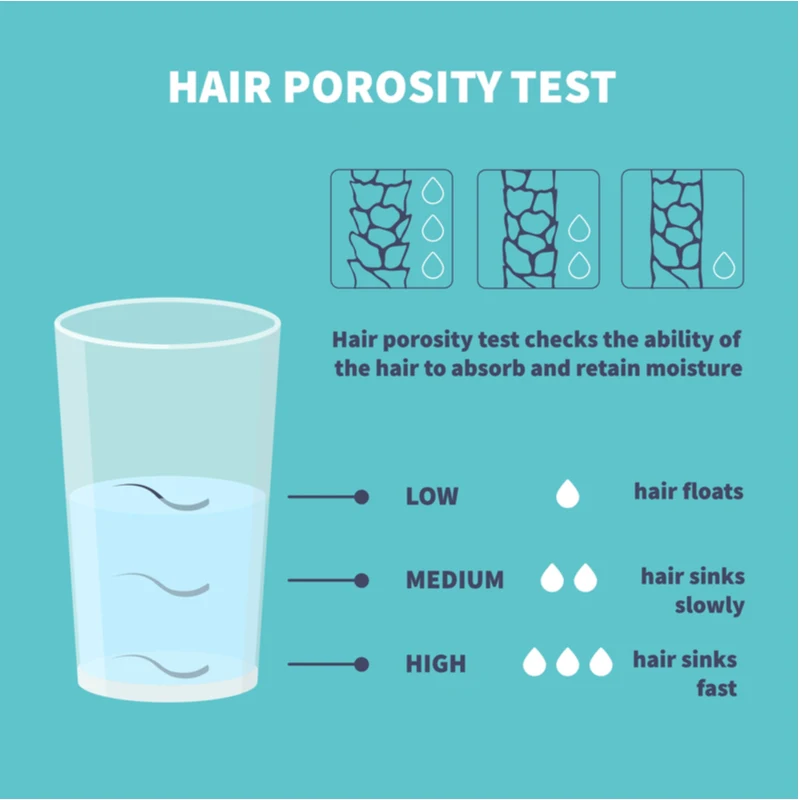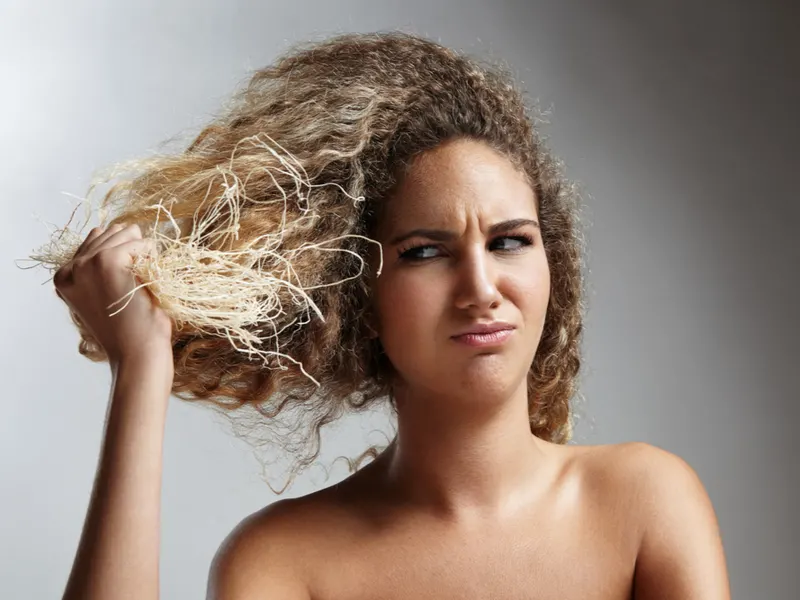Jump to:
Believe it or not, gummy hair after bleaching is a common problem. It is caused by the hair’s porosity being too high. When the hair’s porosity is too high, the cuticles become lifted, and the hair becomes dry, brittle, and gummy.
Have Gummy Hair After Bleaching? Don’t Worry.
Gummy hair after bleaching is an uncomfortable condition caused by the over-processing of hair. The cuticles lift when hair is over-processed, and the hair shaft becomes damaged.
It causes the hair to become dry, brittle, and gummy. Gummy hair lacks protein and moisture, making it difficult to style. Protein gives the hair strength, moisture, and helps keep the hair hydrated.
It can be a scary experience when you see your hair turn into a gummy mess, especially when the damage is so severe that the hair is so brittle that it breaks off easily.
The calming news is that you can repair gummy hair. So don’t panic and think you have to chop it all off. There is a lot to understand about gummy hair after bleaching, but we will start with the basics and show you how to treat it.
What Causes Gummy Hair After Bleaching?

Gladskikh Tatiana/Shutterstock
The fear of gummy hair after bleaching is enough to scare anyone away from the bleaching process. It can leave you with dry and brittle hair too fragile for styling. But what actually causes gummy hair after bleaching?
Over-Processing
There are a few treatments you can try to save gummy hair after bleaching. The most common cause is over-processing the hair. This can happen if you leave the bleach on for too long or use a bleach that is too strong.
Bleaching is suitable for your hair if it’s done correctly. But if you overdo it, the bleach can start to eat away at your hair shaft and damage the cuticles. It can leave your hair feeling dry and gummy.
Bleaching the hair too often can also cause gummy hair. If you’re constantly bleaching your hair, it can become over-processed and damaged. Try to give your hair a break in between bleaching sessions to allow the hair to recover and repair itself.
Porosity
Another cause of gummy hair after bleaching is high porosity. Porosity is the hair’s ability to absorb and retain moisture. High porosity is the primary cause of gummy hair.
Many things can cause high porosity. One is damage to the hair shaft. It can happen as a result of over-processing, heat damage, or chemical damage. Another cause of high porosity is genetics. Some people are just born with high porosity hair.
Try a Porosity Test
The best way to determine if your gummy hair is caused by high porosity is to do a porosity test. The most common is the float test. To do this, you will need a glass of water.
Fill the glass with room temperature water, and then drop a strand of your hair into the glass. Or, you can just take or hair porosity quiz; answer five short questions and we’ll tell you what your porosity is!
Deciphering the Results

art4stock/Shutterstock
If your hair goes down to the bottom, your porosity is low. If your hair floats on the top, your porosity is high. If your hair floats in the middle, your porosity is normal. Hair that sinks to the bottom isn’t absorbing moisture. This is a result of damage to the cuticles.
When the cuticles are damaged, they cannot properly absorb moisture. Your hair is left feeling brittle and stiff. If your hair floats on the top, it means that your hair is absorbing too much moisture due to high porosity.
High porosity hair can be caused by damage to the cuticles, or it can be genetic. If your hair floats in the middle, your hair is absorbing moisture properly. This is the ideal situation for your hair. It likely absorbs moisture effectively and is soft and easy to style.
Clarifying Shampoo
Another common cause of gummy hair is using a clarifying shampoo. Clarifying shampoos are made to strip the hair of build-up, but they can also strip the hair of its natural oils. They have a reputation for leaving the hair feeling dry and brittle.
Clarifying shampoo is one thing to avoid after bleaching your hair. It’s easy just to pick up any shampoo that smells good, but when you’re doing a chemical treatment to your hair, it’s essential to use a product that doesn’t clarify the scalp and hair.
Sulfates
Sulfates are a common ingredient in clarifying shampoos, but they can also be found in other hair products. Sulfates are harmful detergents that can strip the hair of its natural oils, primarily if used too often.
Read product labels to ensure that none of the products you use contain sulfates. Sulfates are what make products lather. If a product doesn’t lather, it probably doesn’t contain sulfates.
You can find sulfate-free products at most stores, but they’re usually more expensive. If you’re on a budget, you can look for products containing sulfates but avoid Sodium Lauryl Sulfate or Sodium Laureth Sulfate (also called SLS) as much as possible.
Read Next: The Best Sulfate-Free Shampoos in 2025
Sodium Lauryl Sulfate
Sodium Lauryl Sulfate is the most common type of sulfate. It’s found in most shampoos, body washes, and toothpaste. It is very harsh and can strip the hair of its natural oils.
Sodium Laureth Sulfate
Sodium Laureth Sulfate is another type of sulfate. It’s less common than sodium lauryl sulfate, but it’s still found in some products. This sulfate can cause the hair to become dry and difficult to style.
Parabens
Parabens are another common ingredient in hair products. Parabens are preservatives that help to extend the shelf life of products. While they’re not necessarily harmful, they can cause the hair to become gummy, especially if it’s been over-processed from bleaching.
Alcohols
There are a few different types of alcohol, but the most common in hair products is ethanol. Ethanol is used in products to help dissolve other ingredients. It can also help to thin out products. It can be a contributing factor to gummy hair.
Hard Water
Hard water is a contributor to damaged hair after bleaching. It contains minerals that can deposit on the hair and scalp, leaving the hair feeling dry, brittle, and gummy.
Read Next: How to Boil Hard Water to Wash Hair
How to Repair Gummy Hair After Bleaching
So now that we understand how all these products and factors can contribute to hair damage caused by bleaching let’s talk about how to repair it.
Protein Treatment
The first step to repairing gummy hair is to use a protein treatment. Protein treatments help strengthen the hair and repair the damage caused by bleaching.
You have options in protein treatment. You can use a store-bought protein treatment or make your own at home. If you decide to use a store-bought protein treatment, look for one that contains keratin or collagen.
These are both proteins that will help to strengthen the hair. If you decide to make your own protein treatment, you can use an egg. Egg whites are high in protein and can help repair damage caused by bleaching.
To use an egg white protein treatment:
- Whisk two egg whites and apply them to your hair.
- Cover your hair with a shower cap and let the treatment sit for 30 minutes.
- Rinse the treatment out with cool water and shampoo as usual.
Read Next: Take Our Does My Hair Need Protein? Quiz
Deep Conditioner
After you’ve done a protein treatment, the next step is to use a deep conditioner. Deep conditioners help to hydrate the hair and repair damage. There are a few different ways to do a deep conditioning treatment.
Beauty supply stores have great options. You can also make your own. If you decide to use a store-bought deep conditioner, look for one that contains shea butter or coconut oil.
These ingredients will help to hydrate the hair. If you decide to make your own deep conditioner, you can use a banana. Bananas are high in moisture and will help to hydrate the hair.
To use a banana deep conditioner:
- Mash one ripe banana and apply it to your hair.
- Cover your hair with a shower cap and let the treatment sit for 30 minutes.
- Rinse the treatment out with cool water and shampoo as usual.
Read Next: Cardi B’s Infamous Hair Mask Recipe
Hot Oil Treatment
The last step to repairing gummy hair is to use a hot oil treatment. Hot oil treatments help to add moisture and shine to the hair. You have the same options of hot oil treatment (homemade and store-bought).
If you decide to use a store-bought hot oil treatment, look for one that contains jojoba oil or argan oil.
These oils will help to add moisture and shine to the hair. If you decide to make your own hot oil treatment, you can use jojoba oil and olive oil. Olive oil is high in moisture and will help add shine and eliminate dryness.
To use an olive oil hot oil treatment:
- Warm up a quarter cup of olive oil and apply it to your hair.
- Wrap your hair in a towel and let the treatment sit for 30 minutes.
- Rinse the treatment out with cool water and shampoo as usual.
Keep the Hair Moisturized
After you’ve repaired the damage caused by bleaching, it’s essential to keep the hair moisturized. The best way to do this is to use a conditioner every time you shampoo your hair. It’s also good to use a leave-in conditioner or oil to keep the hair moisturized.
Apply the conditioner or oil to the ends of your hair and work it up to the middle. Don’t forget to protect your hair from the sun. The sun can damage the hair and make it dry and brittle.
Wear a hat or scarf when you’re going to be in the sun for an extended time. You should also avoid using heat styling tools as much as possible. Heat styling tools can damage the hair and make it dry and brittle.
Be Consistent
The last thing you need to do to repair gummy hair is to be consistent. Consistency is critical when it comes to repairing the damage. You need to ensure that you’re using the right products and following the proper hair care routine.
If you’re not consistent, you won’t be able to repair the damage, and your hair will continue to look gummy. We know it can be tempting to skip a step or two when you’re in a hurry, but it’s important to be consistent if you want to repair your hair.
Frequently Asked Questions

Beauty Stock/Shutterstock
Here are a few of the most commonly asked questions regarding hair that is feeling a little too rubbery after the bleaching process.
Why does my hair feel rubbery after bleaching?
Your hair feels rubbery after bleaching because the bleach has damaged the proteins in your hair. When the proteins in your hair are damaged, they can no longer hold onto moisture. This causes the hair to feel dry, brittle, and rubbery.
What does it mean when your hair feels gummy?
When your hair feels gummy, it means that the proteins in your hair are damaged. Damaged proteins can no longer hold onto moisture, which causes the hair to feel dry, brittle, and gummy.
How do you fix gummy stretchy hair?
The best way to fix gummy, stretchy hair is to use a deep conditioner or hot oil treatment. Deep conditioners and hot oil treatments help to add moisture and shine to the hair.
Can Olaplex fix gummy hair?
Olaplex can help repair some of the damage caused by bleaching, but it won’t fix gummy hair. The best way to fix gummy hair is to use protein treatments, a deep conditioner, and a hot oil treatment.
Read Next: How to Use Olaplex on Hair
How long does it take for over-processed hair to get back to normal?
It can take several months for over-processed hair to get back to normal. The best way to speed up the process is to use a deep conditioner, hot oil treatment, and consistency.
Gummy Hair After Bleaching: Final Thoughts
Gummy hair after bleaching is a common problem that results from over-processing. This causes high porosity leaving the hair dry, brittle, hard to style, and gummy. Knowing that you can repair the hair is refreshing.
The best way to fix it is to be consistent with your hair care routine and use regular protein treatments. Also, use a deep conditioner and hot oil treatment after every wash. If you’re not consistent, it will take longer to reach your goal of healthy lustrous hair.
